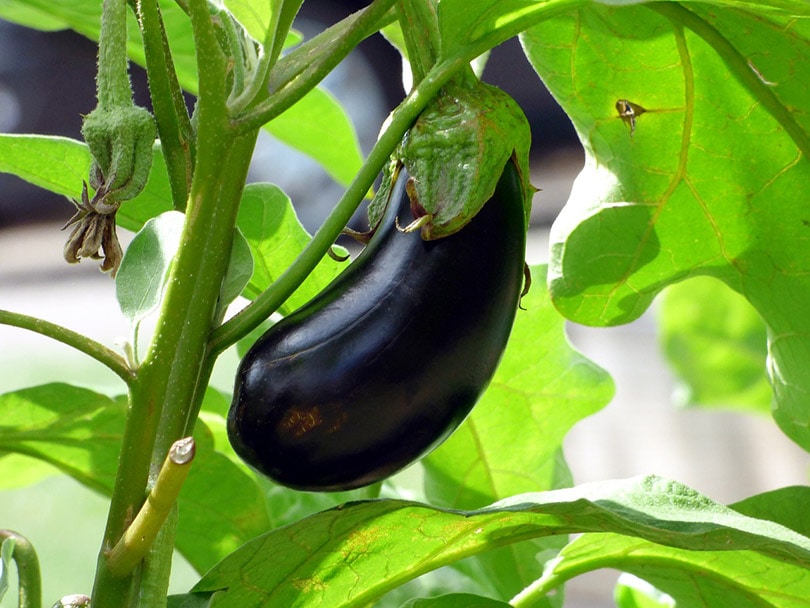Does Eggplant Need a Trellis? Varieties, Facts & FAQ
-
Pete Ortiz
- Last updated:

Eggplants, or aubergines, are related to the tomato and pepper, which is why they combine so well in a salad or other dish. The eggplant itself loves warm weather and will quickly die off if it is faced with too much cold weather. But even if you do live in a climate with cold winters, you can grow them as an annual. And, while the size of the eggplant puts many gardeners with small plots off, they can grow vertically so they are suitable for a square foot garden or for cultivating in planters on your patio.
About Eggplants
Eggplants originated in China and India and were introduced to Europe and the Mediterranean by traders before making their way over to the US. They are popular because they remain firm while being cooked and are especially good when grilled. Their flesh and size mean that they are popular in vegetarian and vegan diets, often used as a meat substitute, but they can also make a great meat accompaniment.

Suitable Eggplant Varieties
The size and stature of the plant, as well as the fruit itself, depends on the cultivar grown.
- The Patio Baby Mini is ideal for those with very restricted growing space. They produce fruit that is approximately 3 inches in length and, while the plants will grow to a height of about 20 inches tall, they won’t spread any further than 20 inches. If kept in a pot, you can ensure that this is as big as they get.
- Black Beauty eggplants grow up to 5 inches long on average but will grow a little longer on occasion, typically only to around 2 feet. They do not spread as far, either, typically only growing out 16 inches.
- The Behold eggplant is medium-sized, growing to 4 feet in height and potentially spreading as wide as 3 feet, so this one does require a little more room than the small varieties above.
All these varieties and many others can be grown vertically.
Growing Eggplants
Eggplants are a summer grower, and they have a short enough harvesting time (typically around 4 months) that they can be sown, grown, and harvested before the cold winter months kill them off.
They don’t like shade and prefer the warmth, so make sure they are given plenty of room and that they won’t be completely surrounded by large shrubs, trees, or other large plants.
Consider warming your soil before planting them. UV-stabilized clear plastic can be placed over the soil and will trap warmth in place. Remove the plastic when it’s time to put the transplants out.
Give each seed 1 square foot of space or choose appropriately-sized containers that will offer this much room.

Staking
As the eggplants grow, you will need to stake them. Eggplant fruits can grow large and heavy, and even the smaller varieties will cause the plant to droop, meaning that the leaves and even the fruits may be left touching damp soil, encouraging fruit rot and other diseases.
The stake should be slightly taller than the maximum height your plant is expected to reach. This will allow you to bury the bottom and still enable the plant to grow to full size. Use garden twine and attach it around the plant and the stake. This will keep the eggplant in place and prevent drooping while making harvesting easier.
Harvesting
To tell whether an eggplant is ready for harvesting, you need to cut it open and check the flesh. It should be cream in color and the fruit should be firm. Seeds should not yet be visible. It may take a few attempts before you get it just right, but after some successful harvests, recognizing when eggplant is ready to be harvested will become second nature.
Eggplant stems do have prickles that can irritate the skin so wear long sleeves and gloves. Use pruners and cut slightly above the cap of the fruit, being careful not to damage the fruit as you remove it.
Conclusion
Eggplants are part of the nightshade family, which also includes tomatoes and peppers. They prefer hot weather and can die prematurely if they are faced with too cold of conditions. However, they have a short enough growing season that it is possible to grow them as annuals, harvesting the ripe fruit before the cold months really settle in. Most eggplant varieties can be grown vertically and in quite a small space. They can even be grown upside down so that the plant doesn’t touch the ground at all.
See also: 23 Companion Plants for Eggplants (With Pictures)
Featured Image Credit: rycky21, Pixabay
Contents


